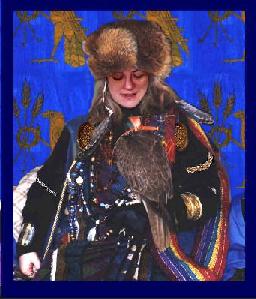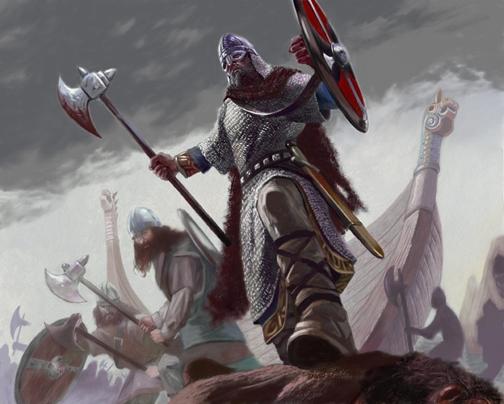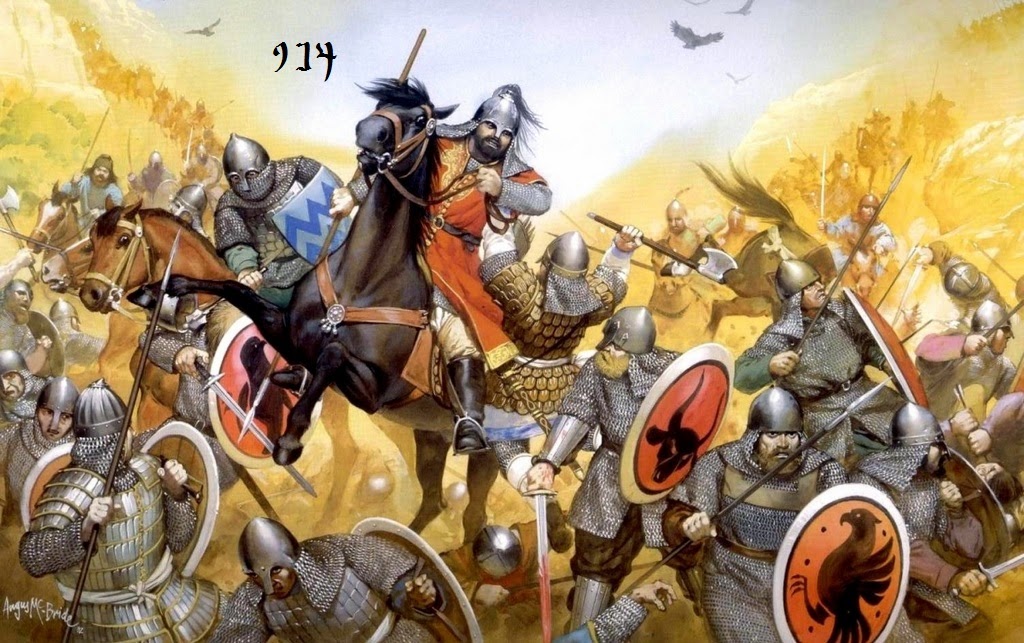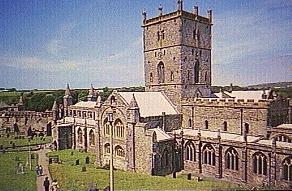
 |
Dear Viking Answer Lady:
|
|
the Viking Answer Lady |
but remains the copyright of Herskerinde Gunnora, the Viking Answer Lady |
| Gentle Reader,
|
|
When the sagas mention Wales, it is called Bretland in Old Norse. Landnámabók
says that the Venerable Bede wrote that the position of the Island of Thule,
or Iceland, was "six days sailing north of Bretland."
Heimskringla recounts that Harald Harfagra gave his favorite
son, Eirík Bloodaxe, the ships and men to go viking when the boy
was only twelve years old: "King Harald gave him five warships, and he
went raiding, first in the Baltic, then south around Denmark and around
Frísland and Saxland, and he was four years on this expedition.
After that he sailed west across the sea, harrying in Scotland, Bretland,
Ireland, and Valland, and passed four more years there", ca. 905 to 910
C.E. Later, Heimskringla tells us that Haraldr outfitted his other
sons, Ţórgísl and Fróđi, in the same manner,
and "they went on Viking expeditions to the West, harrying in Scotland,
Bretland, and Ireland." Eirík Bloodaxe followed his father Haraldr to the Norwegian throne around 930 C.E., but was forced to flee to England by his half-brother Hakon in about 935. The English king Ćţelstan gave York to Eirík in return for Eirík's conversion to Christianity. While King of York, Heimskringla recounts that Eirík's "land was small in size, and therefore he always went on plundering expeditions in summer, harrying in Scotland, the Hebrides, Ireland, and Bretland, and thus gained wealth for himself." But when Ćţelstan's brother Eadmund succeeded him to the English throne, Eirík found that Eadmund "did not care for Norwegians. He and Eirík were no friends. . .when King Eirík heard of that he went on a viking expedition to the west. From the Orkneys he had with him Arnkel and Erlend, the sons of Turf-Einar. From there he sailed to the Hebrides, and there were many vikings and warrior chieftains who joined his expedition. Then he sailed first to Ireland with all his forces, and took with him as many men from there as he could get. Thereupon he sailed to Bretland and harried there." Egils saga Skallagrimssonar also mentions Bretland in connection
with the Battle of Vinheiđr, which may be the same battle that is described
in the Anglo-Saxon Chronicle as the Battle of Brunanburh in 937
C.E.: "Two brothers, Hringr and Ađils, ruled over Bretland, and they
paid tribute to King Ćţelstan. It was part of their service
that when they were in the king's army they and their people should be
in the front ranks in the company with the king's standard. These brothers
were fine warriors and not young men." The brothers were probably from
Strathclyde Wales, and their tale may represent Scandinavian settlement
and rule in some parts of Wales. It is certainly known that Scandinavians
did travel through Strathclyde at times, on the Roman road from York to
Carslile. There was also a Norse settlement in Cumberland which was probably
a part of the Strathclyde Welsh kingdom. It was almost certainly to stop
the Welsh and Norse settlers in Wales from aiding the Norsemen who challenged
Saxon sovreignity that caused King Eadmund to overrun Strathclyde in 944
C.E. and give it to Malcolm King of Scots in exchange for Malcom's promise
to keep the Norse and Welsh in check  King
Harald was quite old by the time Thorolf and Bjorg had stayed with
Bjorg’s father Brynjolf. The king had several large estates but stayed
that winter in the north. He had, among many older sons, one young son
named Eirik Bloodaxe. He was being raised by Thorir Hroaldson and quite
often stayed at Fjord Province. ~ Source
Norse settlements in Wales are also indicated by The Saga of the Jómsvíkings, ca. 930 to 935 C.E.: "At that time a jarl ruled in Bretland whose name was Stefnir. He had a beloved daughter named Álof. She was wise and much beloved. Palnatóki landed there with his fleet and intended to harry Stefnir's land. But when they learned of that, Álof and her counsellor, Björn inn breski (the Welshman), contrived the plan of asking Palnatóki to come to a banquet in his honor so that he should consider this a land of friends and not harry there. Palnatóki accepted the invitation and came to the feast with all his company. And at that feast Palnatóki asked for the hand of Álof, nor was it hard to win. And straightaway they prepared for their marriage, and at the wedding Jarl Stefnir bestowed on Palnatóki the title of jarl and half his land; and after the jarl's death Palnatóki was to have the whole of the land. Palnatóki stayed there both that summer and the winter following." Palnatóki was the foster-father of Svein Forkbeard, who later became King of Denmark. Svein Forkbeard was said in Ólafs saga Tryggvassonar
later to have visited his foster-father Palnatóki in Bretland, after
which he went raiding elsewhere in Wales, "For once upon a time Swein was
plundering in Bretland, and at first was victorious, getting possession
of much booty; but as he advanced far into the country to a distance from
his ships, he was met by a force on horseback, too numerous to be withstood;
he himself was taken prisoner, bound, and cast into prison, with Ţórvaldr
Kodranson and many other distinguished and important men. The next day
there came a powerful duke to the dark dungeon with a large force to fetch
Ţórvaldr out of prison; because when his own sons had been
captured a short time before, Ţórvaldr had given them their
freedom and sent them home to their father. The duke ordered Ţórvaldr
to come forth and go away free; but Ţórvaldr swore that he
would on no account leave the place alive unless King Svein were released
and set free with all his men, and the duke permitted this for Ţórvaldr's
sake." The Welsh Chronicles verify Svein's expedition, mentioning that
in 995 C.E. that "Svein the son of Haraldr plundered in Manaw," probably
Anglesey but perhaps this may be the Isle of Man. Brennu-Njáls saga also describes Viking raids into Wales by the sons of Njáll, Helgi and Grímr. While sailing towards Iceland, the brothers are set upon by Earl Hákon and captured. Kári Sölmundarson, a retainer of Jarl Sigurđr Hlöđvisson, rescued Helgi and Grímr. Later, Kári asks them to raid with him into Wales: "After that, Kári and the Njálssons sailed to Orkney, where Jarl Sigurđr gave them a cordial welcome. They stayed with Jarl Sigurđr that winter. In the spring, Kári asked the Njálssons to come raiding with him, but Grímr would only agree if Kári came to Iceland with them afterwards. Kári gave his promise, and so they went raiding with him. They raided around Anglesey in the south and all round the Hebrides, then made for Kintyre and landed there. They fought the inhabitants and gathered rich booty before returning to their ships. From there they went to Bretland." In Orkneyinga saga, Jarl Ţórfinnr Sigurđarson
of Orkney put together a huge raiding fleet with the help of King Magnús
Barefoot, which engaged the Welsh in the Battle of Menai Straight: " It
was a long hard battle, fought first with bows, then hand-to-hand. For
a good while no one could tell which way the tide would turn. King Magnús
was using a handbow and there was another archer with him, from Halogaland.
Hugh the Proud was putting up a brave fight, and was so well-armored that
only his eyes were exposed, so King Magnus suggested to the archer that
they should both shoot at Hugh together, and that is what they did. One
arrow struck Hugh's noseguard, but the other entered the eyehole and pierced
his head, and there Hugh the Proud fell. The King got credit for it. The
Welsh lost a great many troops and in the end they had to run. King Magnús
had won a famous victory . . ." EGIL’S SAGA: CHAPTER 36; Eirik Bloodaxe |
|
The first raiders were Norwegians, known to the Irish as Finn Gaill, for in 854, the chronicles record a new type of Northman appearing upon the Welsh shores. Like the Irish, who called the Danes Dubh Gaill or "black foreigners," the Welsh called the new sea-rovers appearing upon their shores various names describing them as "black":
Return to Top |

Hroald and Ohtar raided Wales from Brittany they were defeated by Anglo-saxons and Hroald was killed. ~ Source
Wales, in its central position, situated between the Viking kingdoms of Ireland and the Danelaw, was certain to receive the attentions of the Norse sea-raiders. The Welsh coastline, and particularly the island of Anglesey, was a particular target for Hiberno-Norse aggression, being situated conveniently close to the Norse colony of Dublin. Anglesey was attractive to the raiders, not only being the home of the monastic establishments of Penmon, Ynys Seirol and Caer Gybi, but also as Giraldus Cambrensis states in his Descripto Kambriae, Sicut enim montes Ereri cunctis Walliae fertur totius armentis in unum coactis ad pascua, sic insula Moniae triticei graminis fertilitate toti Walliae fertur aliquamdiu sufficere posse. Just as, for instance, Mount Snowdon could produce pasture for all the herds of Wales , thus the isle of Mona is so fertile in wheat and meadows to be able to supply produce for some time for the whole of Wales.It is uncertain whether or not the Norse settled the island, but it seems likeley when one considers that the original Welsh name for the island, Mona, was completely replaced by the Old Norse Öngulsey or Anglesey (though Welsh texts continue to use "Mona" until the present day). Return to Top |

 A raiding party of Vikings referred to as Dub Gint or black pagans under the command of Ingimundr attacked the Welsh in a battle at Ros Meilon or Osmeliavn, perhaps near Holyhead. ~ Source
 Wales : A large Viking fleet arriving from the Éuropean continent ravaged Gwent as far inland as Archenfield, capturing the bishop of Llandaff, named Cameleac, who was later ransomed by the Wessex king Edward the Elder for a sum of forty pounds. ~ Source
 Wales:
Vikings have been wintering at Quatford , but in the spring they
attacked the Southern Wales kingdoms of Brycheiniog, Gwent, and the
Gwynllg region of Glywyssing.
Asser recorded that Elisedd of Brycheiniog requested help from Alfred
the great, but another reason for this may also be due to pressure from
Anarawd ap Rhodri, the powerful king of Gwynedd and Deheubarth who is
keen on expanding his areas of control. Dyfed's Hyfaidd ap Bledrig may
be another southern Welsh king who, during his lifetime, similarly
appeals to Alfred for aid and support to ward off Anarawd. ~ Source
|
|
On Welsh Art, Music and Literature King Gruffydd ap Cynan of Gwynedd, of Norse ancestry himself and raised in the Norse court at Dublin, did much to introduce Scandinavian influences into Welsh art, music, and literature. Gruffydd brought Norse-Irish skalds to court as well as patronizing Welsh bards. Literary parallels between the Welsh Mabinogion and Irish sagas display borrowings by the Welsh tales from the Irish. Scandinavian influences also played a significant role, especially in the tale of Branwen ferch Llyr or The Mabinogi of Branwen, which shows themes from the Nibelungeleid and the Guđrun cycles, Volsunga saga, and Ţidreks saga. Scandinavian themes also find a place in the History of Gruffydd ap Cynan, where Gruffydd's ancestry is said to include King Haraldr Harfagra, the famous Viking Rollo, and Saint Óláfr the King. Musical traditions in Wales were also influenced by Gruffydd's taste
for the Irish pipes, as well as for harping in the Hiberno-Norse style.
Gruffydd maintained a royal harper, Gellan or Crellan, until the musician
was killed in a raid. Gruffydd's court also sponsored competitions for
musicians and minstrels, among whom transplanted Norse and Norse-Irish
performers competed. Gruffudd ap Cynan - Wikipedia |
|
(2) From about 1040 C.E., the Welsh chronicles are two years behind
the true reckoning. In other words, if the Welsh Chronicle states that
an event occurred in 1040, the actual date should be 1042 C.E.
Return to Top
Webpage © 1995-2017
Isle of Standauffish
|